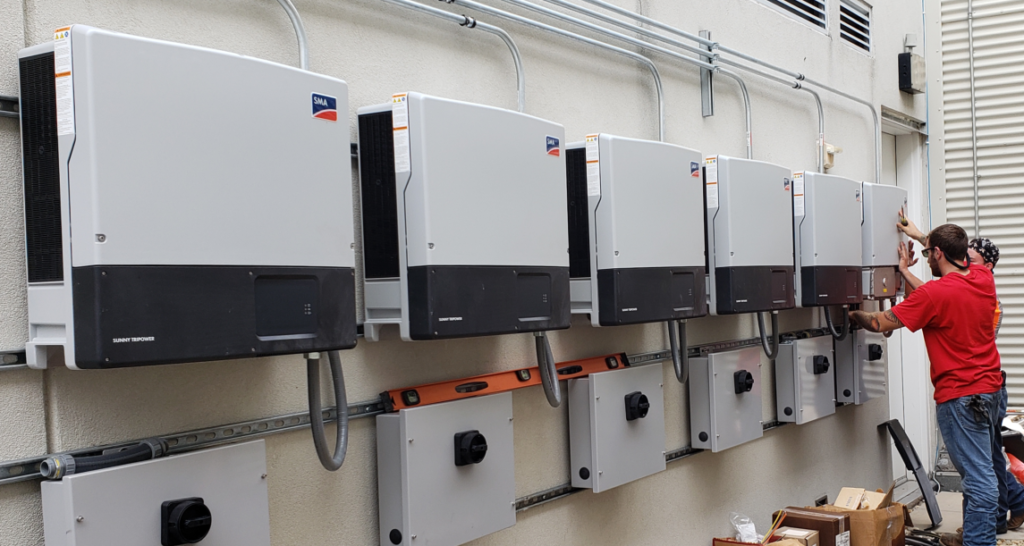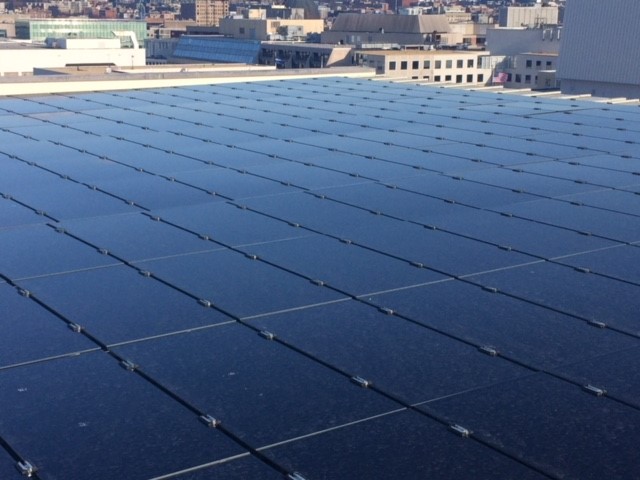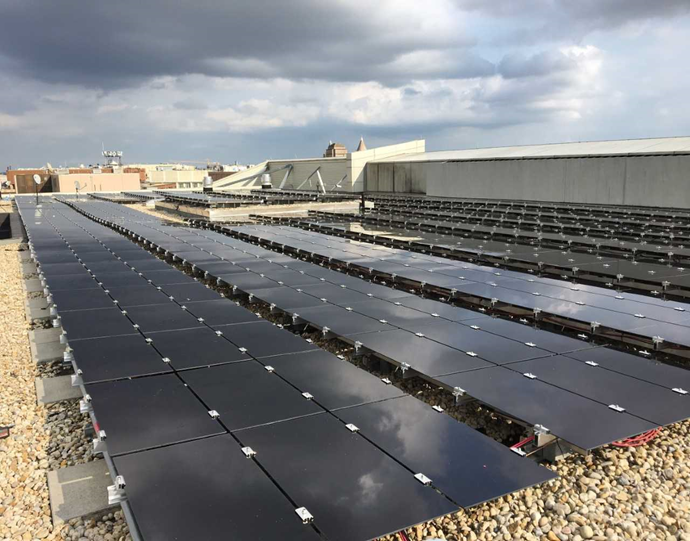At the Port City Press Building in Pikesville, an adaptive re-use project by Garver Development Group transformed a 177,000-square-foot, 75-year-old printing plant into a modern facility supporting light industrial, warehouse and self-storage functions. A $3 million C-PACE loan underwrote the installation of energy-efficient systems and rooftop solar panels that generate enough electricity to satisfy nearly all of the building’s needs.

Financially attractive onsite solar systems come in many forms. In Washington, D.C., Carr Properties installed rooftop solar on three office towers. Although the systems are relatively small and off set just seven percent of the buildings’ electricity consumption, Carr determined they would generate good return on investment. Photo courtesy of Carr Properties.
On a trio of office towers in Washington, D.C., Carr Properties leveraged some of its equity to install rooftop solar systems. Solar systems on multi-story office buildings are relatively small and Carr’s systems which ranged from 70 to 121 kilowatts, generated only enough electricity to offset about seven percent of the base building load. Yet with the combination of energy savings, the sale of SRECs (solar renewable energy credits) and federal tax benefits Carr executives determined the energy savings plus the proceeds from the sale of SRECs (solar renewable energy credits) would generate a sufficient return on investment.
Profitable onsite solar projects at commercial real estate properties come in many forms. Unfortunately, there aren’t formulas that instantly sort good project options from poor ones, options to finance solar projects are shifting, and going solar could require CRE owners to adopt some different business operations. But some experts insist there is ample, unrealized potential to install profitable solar systems on commercial properties.
A key challenge, of course, is figuring out the financials.
“There are four financial levers that people push and pull on to figure out how to underwrite a solar project,” said Jason Schwartzberg, President and Co-Founder of MD Energy Advisors. Those include an investment tax credit, depreciation, use of the power generated and sale of SRECs.
The federal government currently offers a 26% investment tax credit on solar systems, “but if you don’t have federal tax appetite, you can’t monetize that benefit,” Schwartzberg said. Versions of the reconciliation bill, which members of Congress have been working on in recent months, would convert that incentive into a refundable tax credit and make it available to anyone.
The price of SRECs in Maryland has remained fairly consistent — around $78 per credit over the past year, offering reasonable income to many projects. SRECs in the District of Columbia, however, sell for about $380 and those higher priced credits may apply to some Maryland projects that are located on D.C. electricity feeder lines, said Christian Clifford, Vice President of Sustainability at Carr Properties.
 Financing solar projects has sometimes proven complex and challenging in the past. C-PACE is a great option but requires consent from a building’s first mortgage lender when the project is rooftop solar. In order to streamline the financing process, MD Energy Advisors has been focusing on sourcing financing from lenders who understand solar and take a different approach to loan approvals.
Financing solar projects has sometimes proven complex and challenging in the past. C-PACE is a great option but requires consent from a building’s first mortgage lender when the project is rooftop solar. In order to streamline the financing process, MD Energy Advisors has been focusing on sourcing financing from lenders who understand solar and take a different approach to loan approvals.
“We have some folks who cut their teeth in equipment leasing and are getting their heads around solar. They will do five- to 20-year deals and just take a lien on the solar system, not a lien on the building. They finance solar like they would finance another piece of equipment,” Schwartzberg said.
Power generated through onsite solar provides a substantial behind-the-meter cost savings.
“Because those electrons aren’t travelling to you through poles and wires, there’s no transmission and distribution charge which can be 20 to 40 percent of a utility bill,” Schwartzberg said.
Accounting for that cost benefit, however, can pose a challenge.
Owner occupied buildings, Schwartzberg said, “are the low-hanging fruit in this market. With streamlined financing options, there should be greater adoption of solar in the owner-user market. Leveraging the tax credit, monetizing the SRECs and saving on electricity costs can make those projects’ cash-flow positive from day one.”
Self-storage buildings, in particular, offer great (and currently under-utilized) opportunities for profitable rooftop solar installations, he added.
Leased space challenges owners to develop accounting systems for onsite solar that delivers power to tenants. Prologis, which installed 40 megawatts of solar capacity on warehouse rooftops in 2020 and has completed two rooftop installations in Maryland, created its SolarSmart program to bill tenants for the amount of solar energy they use.
Property owners, however, have another option for generating revenue from onsite solar, namely renting out their roof space to a solar company. Remuneration to the owner can be a simple lease or payments tied to the energy generated. Legislation in Maryland — which allowed nonprofits, municipalities and agricultural operations to purchase solar power from aggregators — has increased the market for rooftop locations for solar installations.
After developing its first three solar installations through equity investments, Carr Properties is evaluating funding a planned fourth, 150-kilowatt project in 2022 through a power purchase agreement (PPA) with a third-party solar firm.
“Key benefits of a PPA is you don’t have the equity outlay or the ongoing maintenance responsibility for a solar system,” Clifford said. “You get the certainty of fixed payments for 15 to 25 years or the right to purchase the power generated at a rate lower than the utility’s retail rate”